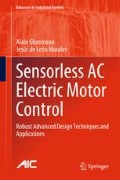Abstract
In this chapter, the IM sensorless control problem is considered, where observer-control schemes are combinations of the observers designed in Chap. 3, with the control strategies proposed in Chap. 5. These observer-controller schemes take into account that the mechanical variables are not measurable (rotor position, rotor speed, and load torque), and only the currents and the voltages are available by measurement. For the induction motor, first an observer-controller scheme is constituted by combining an adaptive interconnected observer with a backstepping controller. The observer is designed to estimate the rotor speed, the fluxes, the load torque, and simultaneously to identify a sensitive parameter: the rotor resistance. The controller is designed to track the reference trajectories of the rotor speed and of the flux modulus. Finally, an observer-controller constituted by an adaptive interconnected observer combined with a high order sliding mode controller is designed. Sufficient conditions are given to ensure the stability of the closed-loop system. Furthermore, the tracking errors convergence of these schemes is analyzed in presence of parametric uncertainties, and a strong uniform practical stability condition is obtained. All these control strategies are experimentally tested on a motor setup using the control benchmark trajectories introduced in Chap. 1 (Sect. 1.6), with parametric uncertainties robustness tests and a non-measured load torque. For all the cases, the Field-Oriented Control (FOC) strategy will be the basis of the control algorithms.
Access this chapter
Tax calculation will be finalised at checkout
Purchases are for personal use only
Notes
- 1.
For each figure, each line is refereed to a, c: measured speed and load torque, e: reference flux, b, d, f, g: estimated speed, load torque, flux, and stator resistance, h, i, j: speed, load torque, and flux estimation error.
- 2.
This chapter includes excerpts from “Traore D, De Leon J, Glumineau A, Loron L (2007) Speed sensorless field-oriented control of induction motor with interconnected observers: experimental tests at low frequencies benchmark. IET Control Theory Applications, 1–6(10):16811692, DOI 10.1049/iet-cta.2009.0648” with permission from IET.
- 3.
This chapter includes excerpts of “Traore D, De Leon J, Glumineau A (2010) Sensorless induction motor adaptive observer-backstepping controller: experimental robustness tests on low frequencies benchmark. IET Control Theory Applications 4(10):19892002, DOI 10.1049/iet-cta.2009.0648” with permission from IET.
- 4.
This chapter, includes excerpts of [89], originally published in the IFAC journal: Automatica, 48:682687, IFAC-PapersOnLine IFAC 2012.
- 5.
This chapter includes excerpts of [86], (2008) IEEE. Reprinted, with permission, from “Traore D, Plestan F, Glumineau A, de Leon J (2008) Sensorless induction motor: High-order sliding-mode controller and adaptive interconnected observer. IEEE Transactions on Industrial Electronics, 55(11):38183827”.
Author information
Authors and Affiliations
Corresponding author
Appendix: Stability of the Observer-Controller Scheme
Appendix: Stability of the Observer-Controller Scheme
Recall that the main goal of this chapter is to synthesize a robust sensorless control of induction motor, assuming that the speed and the flux are not available by measurement, and the load torque is considered as an unknown input. In order to implement the above control law it is necessary to replace speed and flux, the stator resistance, and the stator frequency by their estimated values provided by the observer. To achieve this goal, one rewrites the speed and flux controllers (5.19), and the control inputs (5.28) as functions of the estimate variables as follows:
with \(\tilde{\omega }_{s}\) is the estimation of the stator pulsation defined in (7.15). The reduced model of the induction motor (5.4) in closed-loop with the controls (7.22) is given by
Remark 7.4
In order to avoid a singularity problem in (7.21), the observer is initialized using a flux initial condition different from zero, such that controller (7.21) is well-defined. This condition is actually a physical condition of IM: no flux implies no torque (see [66] for more details). Moreover, the flux controller (7.21) allows to guarantee that \(\phi _{rd}\) quickly reaches its reference \(\phi ^{*}\). Before the motor is fluxed, (i.e., \(\phi _{rd} = \phi ^*\)) the speed reference is kept to zero.
Here, it will be demonstrated that the singularities of controller (7.21) are avoided for all \(t \ge 0\).
The speed and flux tracking error dynamics (5.18) can be rewritten in the following form:
where the estimation errors are
and the nonlinear terms:
Then, one can establish the following lemma.
Lemma 7.2
Consider system (1.108), and assuming that the reference signals \(i_{sq}^*\), \(i_{sd}^*\), \(\varOmega ^*\) and \(\phi ^*\) are differentiable and bounded, and conditions given in Remark 3.17 hold. Then, system (1.108) in closed-loop with the speed, flux, and current tracking laws (7.21) and (7.22), using the estimates provided by an adaptive interconnected observer (3.110), is strongly uniformly practically stable.
The proof follows the same procedure as the control analysis given in Chap. 5.
Rights and permissions
Copyright information
© 2015 Springer International Publishing Switzerland
About this chapter
Cite this chapter
Glumineau, A., de León Morales, J. (2015). Sensorless Output Feedback Control for Induction Motor. In: Sensorless AC Electric Motor Control. Advances in Industrial Control. Springer, Cham. https://doi.org/10.1007/978-3-319-14586-0_7
Download citation
DOI: https://doi.org/10.1007/978-3-319-14586-0_7
Published:
Publisher Name: Springer, Cham
Print ISBN: 978-3-319-14585-3
Online ISBN: 978-3-319-14586-0
eBook Packages: EngineeringEngineering (R0)

